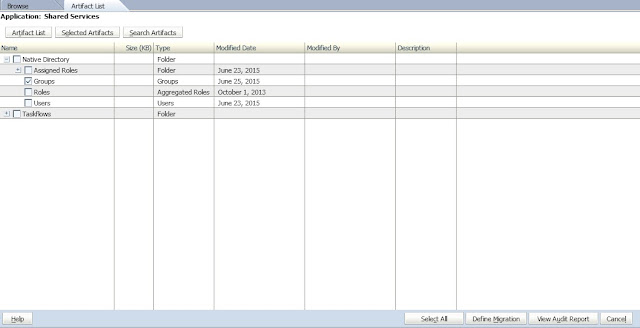Smart View - Accessing Shared Connections from an XML File
Connect only to Essbase through Smart View (no Planning or Reporting and Analysis to be seen under Shared Connection)
In this document, I will explain the process of connecting
to only Essbase through the use of XML.
Starting 11.1.2.3, we can connect to Smart View data sources
using Shared Connection from an XML file which can reside in the server or
client computer. So, basically, we can create an XML file to point to all the
products that we want to connect via Smart View, for example Essbase, Planning,
Reporting and Analysis, Financial Management, etc.
As we know, when we connect to Smart View, we have Essbase,
Planning, Reporting and Analysis, etc nodes in the Shared connection. In my work
environment, however, the Managers want users to see only the Essbase node in
the Shared connection box. They would not want users to see the Planning and
Reporting and Analysis nodes in the connection pane.
We can take the following steps to achieve this. And
basically, we can add other products if we want other products to be visible.
Create an empty XML file. (Open a notepad and
save it as XML. Give a meaningful name). Also make sure to save it in a
meaningful location. In my case I have named the XML file “SmartView_Essbase_Connection.xml”
and I have saved it at “C:\software_nirmal\SmartView_Connection”
Add the following lines: The reason I have them
colored are to show the opening and ending tags.
<?xml
version="1.0" encoding="UTF-8"?>
<res_GetProvisionedDataSources>
<Product id="APS"
name="APS-11.1.2" displayVersion="version">
<Server
name="Oracle Hyperion Provider Services"
context="http://My_Dev_AppServer:19000/aps/SmartView"></Server>
</Product>
</res_GetProvisionedDataSources>
Make sure
that you have proper SERVERNAME, PORT etc for Server Name. Check Smart View
guide and your system configuration, etc to check for those settings. This is
for Essbase only. If you want to add other products, such as Planning,
Reporting and Analysis, etc, you can add them – The “Product ID” and “Server
name” part.
<Product
id="APS" name="APS-11.1.2"
displayVersion="version">
<Server
name="Oracle Hyperion Provider Services"
context="http://webServerHost:19000
or configured
webServerPort number/aps/SmartView"></Server>
</Product>
Now that we have saved the XML file with the
contents that we want, it is time to use the XML to Connect to Essbase through
Smart View. In this example, we will have the XML file in local drive.
a.
Open MS Excel.
b.
Click the SmartView tab and under the SmartView
ribbon, click Options.
c.
Under Advanced -> Shared Connection URL, make
sure to type in the following: C:\software_nirmal\SmartView_Connection\SmartView_Essbase_Connection.xml
(This is the path where XML file in located, followed by the XML file name.)
d.
OK
e.
Panel -> Shared Connection
f.
Now you will see only Oracle Essbase.
The syntax for each provider type is
below.
Provider Services (Essbase)
<Product
id="APS" name="APS-11.1.2"
displayVersion="version">
<Server
name="Oracle Hyperion Provider Services"
context="http://webServerHost:19000
or
configured webServerPort number/aps/SmartView"></Server>
</Product>
Planning
<Product
id="HP" name="HP-11.1.2"
displayVersion="version">
<Server
name="Oracle Hyperion Planning, Fusion Edition" context="http://
Accessing
Shared Connections from an XML File 23
webServerHost:19000
or configured webServerPort number/HyperionPlanning/SmartView"></
Server>
</Product>
Financial Management
<Product
id="HFM" name="HFM-11.1.2"
displayVersion="version">
<Server
name="Oracle Hyperion Financial Management, Fusion Edition"
context="http://
webServerHost:19000
or configured webServerPort number/hfmadf/../hfmofficeprovider/
HFMOfficeProvider.aspx"></Server>
</Product>
Reporting and Analysis
<Product
id="RAFramework" name="RAFramework-11.1.2"
displayVersion="version">
<Server
name="Reporting and Analysis Framework"
context="http://webServerHost:19000
or
configured webServerPort
number/raframework/browse/listXML"></Server>
</Product>
Strategic Finance
<Product
providerType="ExtensionProvider" id="HSF" name="HSF-11.1.2"
displayVersion="version">
<Server
name="Oracle Hyperion Strategic Planning, Fusion Edition"
context="webServerHost:8900
or configured webServerPort number/StrategicPlanning/
SmartView"></Server>
</Product>
Oracle BI EE
<Product
providerType="ExtensionProvider"
id="27EE9B0D-D5F5-42c9-AFC5-44FEA770C693"
name="OBI
EE-11.1.1.7" displayVersion="version">
<Server
name="Oracle BI, Fusion Edition"
context="OBI:http://webServerHost:9704 or
configured
webServerPort number/analytics/jbips"></Server>
</Product>






















